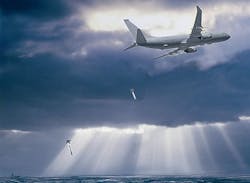Navy to beef-up supply of anti-submarine warfare sonobuoys in $195.2 million deal with ERAPSCO
PATUXENT RIVER NAS, Md., 10 Nov. 2014. U.S. Navy anti-submarine warfare (ASW) experts are replenishing their supplies of air-launched sonobuoys with a variety of capabilities ranging from taking the temperature of ocean layers at different depths, to detonating submerged explosive charges.
Officials of the Naval Air Systems Command at Patuxent River Naval Air Station, Md., announced a $195.2 million contract modification Friday to ERAPSCO Inc. in Columbia City, Ind., for as many as 141,500 AN/SSQ series sonobuoys, and 10,000 MK-84 signal underwater sound devices.
Sonobuoys enable Navy ASW forces to detect, track, and pinpoint potentially hostile submarines operating in the open ocean that could be threats to Navy carrier battle groups or other forces. Information from these systems can help enable precision attacks with air-launched torpedoes.
Aircraft can drop a pattern of sonobuoys, which relay information back to the aircraft by radio link, to determine the exact locations of enemy submarines.
The AN/SQQ series of sonobuoys consists of the SSQ-36 bathythermograph (BT); SSQ-53 passive directional low frequency analyze and record (DIFAR); SSQ-62 directional command active sonobuoy system (DICASS); SSQ-101 air deployed active receiver (ADAR); SSQ-110 multi-static non-coherent source; and SSQ-125 multi-static coherent source.
The AN/SSQ-36B provides vertical temperature profiles of the ocean layer for ASW and research, and used widely in ASW operations to evaluate local effects of seawater temperature on sonar propagation and acoustic range prediction.
Related: Navy makes order of submarine-hunting sonobuoys for helicopters and patrol aircraft
The AN/SSQ-53F uses four hydrophones -- each one a multichannel directional piezoelectric ceramic transducer -- that operate at depths of 90, 200, 400, and 1,000 feet to listen for potentially hostile submerged enemy submarines. Aircraft can drop a pattern of sonobuoys, which relay information back to the aircraft by radio link, to determine the exact locations of enemy submarines.
The SSQ-53F has three sensors: a constant shallow omni (CSO), an advanced DIFAR sensor, and a calibrated wideband omni. The buoy digitally conditions and amplifies the acoustics and provides directional data that helps establish azimuthal bearing to the submarines being tracked.
The AN/SSQ-62E DICASS sonobuoy is for detecting and localizing submarines in preparation for attack. I can provide range and bearing to the target to fix position, and can support any of the four acoustic frequencies as selected via the Electronic Function Select.
Related: Navy Boeing P-8 maritime patrol jet to receive anti-submarine warfare (ASW) system upgrades
The AN/SSQ-101 ADAR sonobuoy provides a commandable passive search capability, and functions as the receiver in a multistatic active receiver system. The device uses a pentagon-shaped horizontally oriented pattern of hydrophones to detect and beamform underwater sound waves.
The AN/SSQ-110/A extended echo ranging (EER) sonobuoy operates on one of 31 selectable RF channels. Its upper section performs control functions and is similar to the AN/SSQ-62 DICASS sonobuoy. The lower section has two signal underwater sound (SUS) explosive payloads.
The AN/SSQ-125 sonobuoy is a source in a multistatic field, and can generate a variety of waveforms, and is designed to work with the AN/SSQ-53F, AN/SSQ-77C, and AN/SSQ-101 (ADAR) sonobuoys.
Related: Navy taps Undersea Sensor Systems for advanced submarine-hunting sonobuoys
The AN/SSQ-125’s RF channel can be programmed to any of the standard sonobuoy operating channels. At any time after deployment, the AN/SSQ-125 can be commanded to change its operating parameters or depth (deeper only), generate a ping, or scuttle.
The SUS MK-84 submarine communications device, meanwhile is an expendable electro-acoustic device that provides one-way acoustic communications with submarines, as well as simulating the drop of an ASW weapon during tactical exercises.
It can transmit any of five pre-selected coded acoustic signals, each of which may convey a predetermined message to the submarine. Four of these signals consist of a continuous tone that alternates in frequency according to a timing sequence defined in a coded table.
Related: Navy seeks to enhance undersea surveillance to optimize anti-submarine warfare operations
ERAPSCO operates as a joint venture between the Sparton Corp. Defense & Security segment in Le Leon Springs, Fla., and Ultra Electronics USSI in Columbia City, Ind.
The company will do the work on this contract in DeLeon Springs, Fla., and Columbia City, Ind., and should be finished by September 2016. ERAPSCO will be paid for this job based on individual delivery orders as they are issued.
For more information contact ERAPSCO online at http://erapsco.com, Sparton Defense & Security at http://sparton.com, or Naval Air Systems Command at www.navair.navy.mil.

